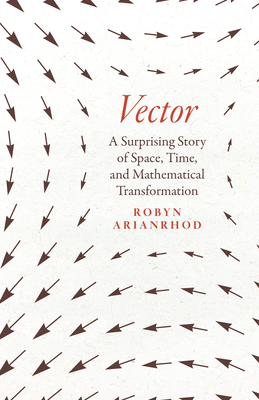
Vector: A Surprising Story of Space, Time, and Mathematical Transformation
Description
A celebration of the seemingly simple idea that allowed us to imagine the world in new dimensions—sparking both controversy and discovery.
The stars of this book, vectors and tensors, are unlikely celebrities. If you ever took a physics course, the word “vector” might remind you of the mathematics needed to determine forces on an amusement park ride, a turbine, or a projectile. You might also remember that a vector is a quantity that has magnitude and (this is the key) direction. In fact, vectors are examples of tensors, which can represent even more data. It sounds simple enough—and yet, as award-winning science writer Robyn Arianrhod shows in this riveting story, the idea of a single symbol expressing more than one thing at once was millennia in the making. And without that idea, we wouldn’t have such a deep understanding of our world.
Vector and tensor calculus offers an elegant language for expressing the way things behave in space and time, and Arianrhod shows how this enabled physicists and mathematicians to think in a brand-new way. These include James Clerk Maxwell when he ushered in the wireless electromagnetic age; Einstein when he predicted the curving of space-time and the existence of gravitational waves; Paul Dirac, when he created quantum field theory; and Emmy Noether, when she connected mathematical symmetry and the conservation of energy. For it turned out that it’s not just physical quantities and dimensions that vectors and tensors can represent, but other dimensions and other kinds of information, too. This is why physicists and mathematicians can speak of four-dimensional space-time and other higher-dimensional “spaces,” and why you’re likely relying on vectors or tensors whenever you use digital applications such as search engines, GPS, or your mobile phone.
In exploring the evolution of vectors and tensors—and introducing the fascinating people who gave them to us—Arianrhod takes readers on an extraordinary, five-thousand-year journey through the human imagination. She shows the genius required to reimagine the world—and how a clever mathematical construct can dramatically change discovery’s direction.
Praise for Vector: A Surprising Story of Space, Time, and Mathematical Transformation
“Everyone understands what it means to move at some particular speed in some particular direction. But it took a long time to start thinking of such behavior in terms of a single clarifying concept, the vector. Arianrhod’s lively and detailed chronicle explains why vectors and tensors are at the heart of our best ways to think about the universe.”
— Sean Carroll, author of "The Biggest Ideas in the Universe"
“There have been lots of books about the evolution of modern physics: from Newton to Maxwell to Einstein and on to quantum theory. But seldom does an author pay attention to the mathematical revolutions that made those physical theories possible. Only as the mathematical toolkit expanded from simple scalars to include such tools and ideas as quaternions and vectors and tensors could physicists and mathematicians find the language to describe an increasingly bewildering universe. Arianrhod does a remarkable job telling the story of the mathematical revolution under the hood, the engine that drove the physics revolutions of the nineteenth and twentieth centuries; the result is a book well worth your time.”
— Charles Seife, author of "Zero: The Biography of a Dangerous Idea"
“With a flair for exposition that makes the complex simple, and a gift for storytelling, Arianrhod is without peer in conveying the beauty, and power, of mathematics. William Rowan Hamilton, James Clerk Maxwell, and Albert Einstein come alive in this dramatic tale of a simple idea that changed our world.”
— Amir Alexander, author of "Infinitesimal: How a Dangerous Mathematical Theory Shaped the Modern World"
“Arianrhod’s Vector, a masterpiece of science exposition, reads as a welcoming cognitive cliffhanger tour of vectors, their generalizations, and their accompanying symbolic tools of mathematical physics, all dovetailing through germane history vignette accounts of astonishing connections and applications.”
— Joseph Mazur, author of "The Clock Mirage: Our Myth of Measured Time"
“‘If all mathematics disappeared,’ physicist Richard Feynman opined, ‘it would set physics back precisely one week.’ To which mathematician Mark Kac retorted, ‘Precisely the week in which God created the world.’ Arianrhod persuades us that vectors and tensors are among those creations. Students and teachers should read this excellent book together.”
— Marjorie Senechal, Smith College, editor-in-chief of "The Mathematical Intelligencer"
“Arianrhod shows, with beautiful ease, that maths is not some foreign world only geeks inhabit. It is the world around us.”
— Adam Spencer
"A vector is quantity that has magnitude and, crucially, direction. This idea has enabled physicists and mathematicians to imagine and describe the world in new dimensions. The author traces the influence of vectors over the past 5,000 years, and why vectors (and tensors) are still relevant today."
— The Bookseller
